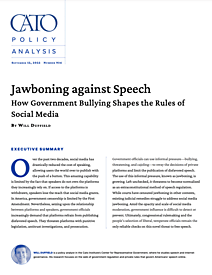The public’s reliance on social media platforms has created new opportunities for censorship by proxy, despite the First Amendment’s prohibition on government speech regulation. Will Duffield’s recent policy analysis “Jawboning against Speech: How Government Bullying Shapes the Rules of Social Media” details how government officials increasingly use informal pressure to compel the suppression of disfavored speakers on platforms like Facebook and Twitter.
However, the specifics of this bullying, and what to do about it, remain contested. Does jawboning require a threat? When can coordination between platforms and government be voluntary? Solutions to jawboning must respect platforms’ rights and cannot inhibit congressional debate. What, then, can be done?
Please join Will Duffield, Adam Kovacevich, and Jenin Younes at the Cato Institute or online for a conversation about this novel threat to free speech.
(Lunch to follow)





